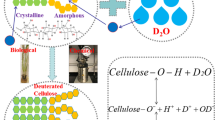Abstract
We report an FTIR method to measure the accessibility and the size of cellulose microfibrils from the cell wall of Valonia ventricosa. This method is similar to the conventional deuteration technique for measuring the accessibility of cellulosic materials; however, the difference in our method is that the hydroxyl groups O2H, O3H, and O6H in the crystalline region were initially completely deuterated. The sample was then rehydrogenated by soaking in water at 25 °C, so that the OD groups on the surface were rehydrogenated. The ratio of OH to OD absorbance was used to calculate the number of surface vs. core cellulose chains in a microfibril. The obtained experimental ratio of 0.934 was consistent with the value calculated for a previously published 33 × 38 chain Valonia model (Sugiyama et al. 1984). The rehydrogenation process was further investigated by immersing the sample in water at elevated temperatures. At temperatures above 120 °C, rehydrogenation was more efficient, and the efficiency plots vs. rehydrogenation temperature showed two inflection. These points may correspond to the temperature where the cleavage of inter-chain hydrogen bonds and/or crystalline-phase transition would have been occurred.





Similar content being viewed by others
References
Frilette VJ, Hanle J, Mark H (1948) Rate of exchange of cellulose with heavy water. J Am Chem Soc 70:1107–1113
Howsmon JA, Sisson WA (1954) Submicroscopic structure. In: Emill O, Harold MS, Mildred WG (eds) Cellulose and cellulose derivatives, Part 1. Interscience Publishers, Inc., New York, pp 231–346
Kim N-H, Hearth W, Vuong R, Chanzy H (1996) The cellulose system in the cell wall of Micrasterias. J Struct Biol 117:195–203
Kokot S, Czarnik-Matusewicz B, Ozaki Y (2002) Two-dimensional correlation spectroscopy and principal component analysis studies of temperature-dependent IR spectra of cotton-cellulose. Biopolymers 67:456–469
Lehtio J, Sugiyama J, Gustavsson M, Fransson L, Linder M, Teeri TT (2003) The binding specificity and affinity determinants of family 1 and family 3 cellulose binding modules. Proc Natl Acad Sci USA 100:484–489
Márechal Y, Chanzy H (2000) The hydrogen bond network in I-beta cellulose as observed by infrared spectrometry. J Mol Struct 523:183–196
Montanari S, Rountani M, Heux L, Vignon MR (2005) Topochemistry of carboxylated cellulose nanocrystals resulting from TEMPO-mediated oxidation. Macromolecules 38:1665–1671
Nishiyama Y, Isogai A, Okano T, Muller M, Chanzy H 1999 Intracrystalline deuteration of native cellulase. Macromolecules 32:2078–2081
Nishiyama Y, Langan P, Chanzy H (2002) Crystal structure and hydrogen-bonding system in cellulose 1 beta from synchrotron X-ray and neutron fiber diffraction. J Am Chem Soc 124:9074–9082
Nishiyama Y, Sugiyama J, Chanzy H, Langan P (2003) Crystal structure and hydrogen bonding system in cellulose 1(alpha), from synchrotron X-ray and neutron fiber diffraction. J Am Chem Soc 125:14300–14306
Revol JF (1982) On the cross-sectional shape of cellulose crystallites in Valonia ventricosa. Carbohydr Polym 2:123–134
Sugiyama J, Harada H Fujiyoshi Y, Uyeda N (1984) High resolution observations of cellulose microfibrils. Mokuzai Gakkaishi 30:98–99
Sugiyama J, Persson J, Chanzy H (1991) Combined infrared and electron-diffraction study of the polymorphism of native celluloses. Macromolecules 24:2461–2466
Tsuboi M (1957) Infrared spectrum and crystal structure of cellulose. J Polym Sci 25:159–171
Wada M (2002) Lateral thermal expansion of cellulose Iβ and IIII polymorphs. J Polym Sci, Part B: Polym Phys 40:1095–1102
Wada M, Okano T, Sugiyama J (1997) Synchrotron-radiated X-ray and neutron diffraction study of native cellulose. Cellulose 4:221–232
Acknowledgements
A part of this study was supported by Grant-in-Aid for Scientific Research (No. 17580142). The authors also express their appreciation to Prof. H. Yano and Dr. K. Abe from Kyoto University for allowing the use of the FESEM and for their technical advice.
Author information
Authors and Affiliations
Corresponding author
Rights and permissions
About this article
Cite this article
Horikawa, Y., Sugiyama, J. Accessibility and size of Valonia cellulose microfibril studied by combined deuteration/rehydrogenation and FTIR technique. Cellulose 15, 419–424 (2008). https://doi.org/10.1007/s10570-007-9187-z
Received:
Accepted:
Published:
Issue Date:
DOI: https://doi.org/10.1007/s10570-007-9187-z




